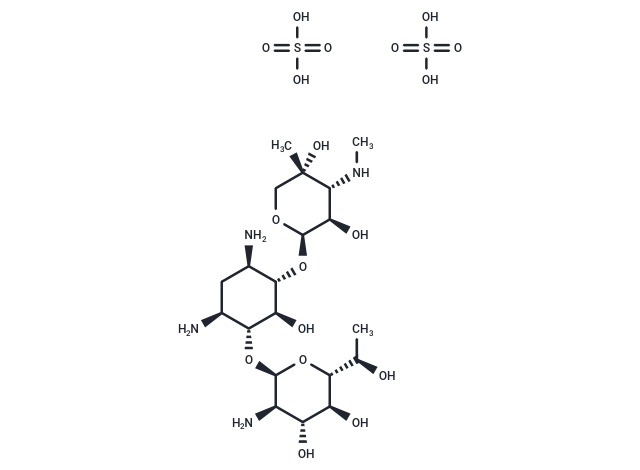Shopping Cart
Remove All Your shopping cart is currently empty
Your shopping cart is currently empty
G-418 disulfate (Geneticin sulfate) is an aminoglycoside antibiotic that selectively inhibits eukaryotic protein synthesis by blocking peptide chain elongation.

| Pack Size | Price | USA Warehouse | Global Warehouse | Quantity |
|---|---|---|---|---|
| 25 mg | $37 | In Stock | In Stock | |
| 50 mg | $51 | In Stock | - | |
| 100 mg | $72 | In Stock | - | |
| 500 mg | $171 | - | In Stock |
| Description | G-418 disulfate (Geneticin sulfate) is an aminoglycoside antibiotic that selectively inhibits eukaryotic protein synthesis by blocking peptide chain elongation. |
| Targets&IC50 | 3T3 cells:213 µg/mL, BHK-21 cells:69 µg/mL, CHO-K1 cells:311 µg/mL, HeLa cells:483 µg/mL |
| In vitro | Continuous administration of G418 at doses ranging from 40 to 80 mg/kg for three consecutive days is sufficient to eradicate all untransfected Brucella bacterium parasites in infected mice. |
| In vivo | At concentrations ranging from 1 to 300 micrograms/ml, G418 inhibits a variety of prokaryotic and eukaryotic organisms. Typically, concentrations of 5 mg/L or lower are effective against bacteria and algae, while a concentration of 400 mg/L is used for the selection of mammalian cells, and a maintenance concentration for mammalian cells is set at 200 mg/L. |
| Synonyms | Geneticin sulfate, Geneticin, G418 Sulfate, Antibiotic G-418 sulfate |
| Molecular Weight | 692.71 |
| Formula | C20H40N4O10·2H2O4S |
| Cas No. | 108321-42-2 |
| Smiles | OS(O)(=O)=O.OS(O)(=O)=O.CN[C@@H]1[C@@H](O)[C@@H](O[C@H]2[C@H](N)C[C@H](N)[C@@H](O[C@H]3O[C@H]([C@@H](C)O)[C@@H](O)[C@H](O)[C@H]3N)[C@@H]2O)OC[C@]1(C)O |
| Relative Density. | no data available |
| Color | White |
| Appearance | Solid |
| Storage | store under nitrogen,store at low temperature | Powder: -20°C for 3 years | In solvent: -80°C for 1 year | Shipping with blue ice/Shipping at ambient temperature. | |||||||||||||||||||||||||||||||||||
| Solubility Information | H2O: 252 mg/mL (363.79 mM), Sonication is recommended. DMSO: Insoluble | |||||||||||||||||||||||||||||||||||
Solution Preparation Table | ||||||||||||||||||||||||||||||||||||
H2O
| ||||||||||||||||||||||||||||||||||||
| Size | Quantity | Unit Price | Amount | Operation |
|---|

Copyright © 2015-2026 TargetMol Chemicals Inc. All Rights Reserved.